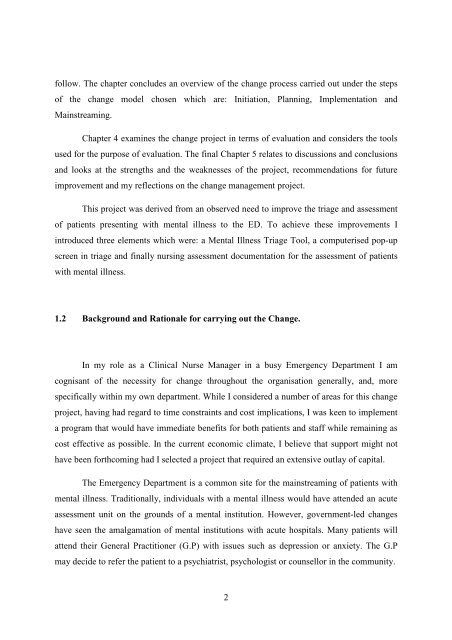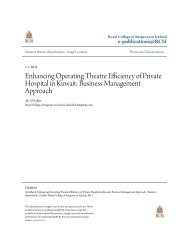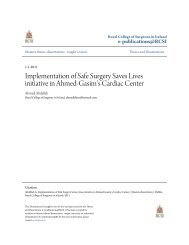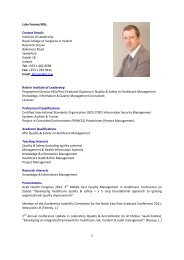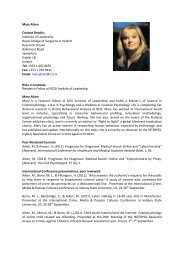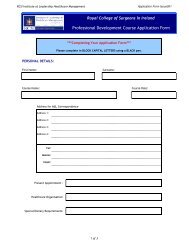Improving the Assessment and Triage of Patients with Mental Illness ...
Improving the Assessment and Triage of Patients with Mental Illness ...
Improving the Assessment and Triage of Patients with Mental Illness ...
You also want an ePaper? Increase the reach of your titles
YUMPU automatically turns print PDFs into web optimized ePapers that Google loves.
follow. The chapter concludes an overview <strong>of</strong> <strong>the</strong> change process carried out under <strong>the</strong> steps<br />
<strong>of</strong> <strong>the</strong> change model chosen which are: Initiation, Planning, Implementation <strong>and</strong><br />
Mainstreaming.<br />
Chapter 4 examines <strong>the</strong> change project in terms <strong>of</strong> evaluation <strong>and</strong> considers <strong>the</strong> tools<br />
used for <strong>the</strong> purpose <strong>of</strong> evaluation. The final Chapter 5 relates to discussions <strong>and</strong> conclusions<br />
<strong>and</strong> looks at <strong>the</strong> strengths <strong>and</strong> <strong>the</strong> weaknesses <strong>of</strong> <strong>the</strong> project, recommendations for future<br />
improvement <strong>and</strong> my reflections on <strong>the</strong> change management project.<br />
This project was derived from an observed need to improve <strong>the</strong> triage <strong>and</strong> assessment<br />
<strong>of</strong> patients presenting <strong>with</strong> mental illness to <strong>the</strong> ED. To achieve <strong>the</strong>se improvements I<br />
introduced three elements which were: a <strong>Mental</strong> <strong>Illness</strong> <strong>Triage</strong> Tool, a computerised pop-up<br />
screen in triage <strong>and</strong> finally nursing assessment documentation for <strong>the</strong> assessment <strong>of</strong> patients<br />
<strong>with</strong> mental illness.<br />
1.2 Background <strong>and</strong> Rationale for carrying out <strong>the</strong> Change.<br />
In my role as a Clinical Nurse Manager in a busy Emergency Department I am<br />
cognisant <strong>of</strong> <strong>the</strong> necessity for change throughout <strong>the</strong> organisation generally, <strong>and</strong>, more<br />
specifically <strong>with</strong>in my own department. While I considered a number <strong>of</strong> areas for this change<br />
project, having had regard to time constraints <strong>and</strong> cost implications, I was keen to implement<br />
a program that would have immediate benefits for both patients <strong>and</strong> staff while remaining as<br />
cost effective as possible. In <strong>the</strong> current economic climate, I believe that support might not<br />
have been forthcoming had I selected a project that required an extensive outlay <strong>of</strong> capital.<br />
The Emergency Department is a common site for <strong>the</strong> mainstreaming <strong>of</strong> patients <strong>with</strong><br />
mental illness. Traditionally, individuals <strong>with</strong> a mental illness would have attended an acute<br />
assessment unit on <strong>the</strong> grounds <strong>of</strong> a mental institution. However, government-led changes<br />
have seen <strong>the</strong> amalgamation <strong>of</strong> mental institutions <strong>with</strong> acute hospitals. Many patients will<br />
attend <strong>the</strong>ir General Practitioner (G.P) <strong>with</strong> issues such as depression or anxiety. The G.P<br />
may decide to refer <strong>the</strong> patient to a psychiatrist, psychologist or counsellor in <strong>the</strong> community.<br />
2


